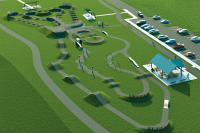Wrong bear euthanized in Smokies incident
 The case of a 400-pound bear euthanized after a hiker in the Great Smoky Mountains National Park was bitten in the leg appears to have been a wrongful conviction. DNA results delivered Monday (May 23) showed that the bear that bit 49-year-old Bradley Veeder, of Las Vegas, on May 10 and the one that park staff euthanized May 13 were two different animals.
The case of a 400-pound bear euthanized after a hiker in the Great Smoky Mountains National Park was bitten in the leg appears to have been a wrongful conviction. DNA results delivered Monday (May 23) showed that the bear that bit 49-year-old Bradley Veeder, of Las Vegas, on May 10 and the one that park staff euthanized May 13 were two different animals.
“Every bear, like every dog, like every cat, like every human, has his or her own unique personality,” said Bill Lea, a longtime nature photographer who’s spent thousands of hours photographing bears in the park. “It just saddens me when we lose an individual life like that. Especially when being executed for something that he or she didn’t do.”
It is a shame that the wrong bear died, agreed Superintendent Cassius Cash, but in this case it was unavoidable. Park staff made the best decision they could with the information they had but unfortunately wound up having the wrong bear.
“Bears are iconic symbols in the Smokies and a decision to euthanize an animal is not made lightly,” Cash said. “Park staff have worked diligently over the last year to develop viable alternatives to euthanasia. Understandably, these options won’t be appropriate responses for every bear incident.”
The incident occurred after 11 p.m. on May 10 when Veeder was asleep in his tent, about 200 yards from the A.T. shelter at Spence Field and nearby a number of other backpackers also using the shelter. His food and toiletries were properly hung on bear cables in an odor-trapping bag, and while his pack was in his tent with him, all it contained was an umbrella, water filter, down vest, cell phone, book and a 1-ounce, unopened container of sunscreen. He’d done everything right, food storage-wise.
The bear approached the tent and bit Veeder’s leg through the canvas, resulting in significant puncture wounds. The hikers camping in the area gathered in the backcountry shelter for the rest of the night, with the bear returning later to tear through Veeder’s tent and another vacant tent nearby.
Related Items
In the morning, Veeder was taken out of the backcountry on horseback to Blount Memorial Hospital and has since been released.
The park then closed the shelter and began monitoring the area. Three days after the incident, the 400-pound bear was tranquilized, and eventually euthanized. Though nobody camping that night had actually seen the bear, it fit the profile, said the park’s management assistant Dana Soehn — it had returned to the site, so it probably called the area home; it had dental injuries consistent with what had happened to Veeder’s leg; and large, dominant male bears are usually the culprits in these circumstances.
Lea takes issue with that last justification, saying that in his experience large, male bears are usually the ones most likely to be afraid of people.
“I always find that the bears most likely to misbehave are more the yearling bears who are just kind of like a teenager, just learning what life is all about,” he said.
The euthanized bear was too big to transport out of the backcountry — Spence Field is six miles from the nearest road — and its neck was so large that fitting it with a GPS collar to find it later was impossible, Soehn said, like trying to put a collar on a coat.
However, park personnel have been working to improve their response to these kinds of incidents ever since something similar happened in the Hazel Creek area on June 6 of last year. A teenage boy sleeping in a hammock was attacked by a bear, and the bear park personnel put down afterward turned out to be the wrong one.
Superintendent Cassius Cash said afterward that he’d want to look at building new protocols to hold bears suspected of violence until DNA tests could be returned. The process is now much faster than it used to be, so it’s feasible to humanely hold bears while waiting for results.
The solutions park staff had come up with didn’t help in the case of the euthanized 400-pounder, but they did allow a 200-pound bear captured May 20 to be spared. The bear, found near the site of the incident, was tranquilized, fit with a GPS collar and released. DNA results cleared this bear, as well.
“Putting the GPS collar on the bear allowed us enough time to get the DNA analysis back in two days,” Soehn said. “That’s the kind of ability we have not had in the past.”
The two-day timeframe is even faster than the turnaround last year. In 2015, the park had sent its DNA samples to a lab in Pennsylvania that has extensive experience with bear DNA, surprised to find the turnaround time shrink to just one week when it used to take multiple weeks. But now they’re working with Western Carolina University to process the DNA, sending samples to both labs to see if they get the same results. The two labs did come out with matching results, and WCU was able to deliver results just two days after the sample was taken from the second bear.
Soehn said WCU’s performance was “outstanding” but allowed that the park may continue to send to both facilities, as the Pennsylvania lab’s extensive library of samples could still prove helpful. It costs $225 to get a sample processed there.
Though the May 10 incident is the one that’s gotten all the press, it’s not the only human-bear encounter that has occurred in the park this year. It’s just the only one that’s resulted in a human injury. Bears have been rustling for food in campsites across the park over the course of the last month or so and will likely continue to do so until berries ripen in July and their food prospects expand.
“Historically we see more aggressive bear behavior during the months of May and June,” Soehn said.
Lea, however, takes issue with terms such as “aggressive” and “predatory.” In his view, the May 10 incident was just a case of a bear doing what a bear does — looking for an easy meal. And not one that involves human flesh.
“Regardless of nearly every precaution you could possibly take, to a bear’s sensitive sense of smell there are going to be some odors associated with a backpacker and his or her clothes or equipment,” he said.
To the bear, Lea said, the presence of Veeder’s leg and the man’s subsequent scream was likely a frightening surprise when all he’d wanted was a taste of some trace smell in the tent. The fact that the bear returned later to ravage an empty tent is, to Lea, proof that the attack was non-predatory — the bear took a bite, got scared by what was between his jaws, and then came back later to sniff out what he was really after.
In the end, though, Lea doesn’t take issue with the decision to euthanize the bear responsible — just with the fact that the wrong bear suffered and attack was labeled as predatory.
“I understand the need to deal with the situation, but don’t mislabel bears as being a predator when they’re seeking food from the smell of food and not trying to kill people to eat them,” he said.
Soehn defends the predatory label but says the park will continue looking for new ways to spare bears that haven’t yet been proven guilty.
“We continue to try to develop these different types of technologies and techniques that help us reduce that risk that we’re going to euthanize an uninvolved bear,” she said. “Fortunately it is a rare occurrence.”
Be safe in the backcountry
Bears are numerous in the Smokies, but aggression toward humans is rare. To minimize the risk:
• Travel in groups of three or more. If you are hiking alone, be sure to make noise frequently to alert any bears in the area that you’re coming their way.
• Carry bear spray where it will be easy to grab and know how to use it.
• When camping, hang all food, toiletries and anything else with an associated scent on a tree branch or bear cables. Even better, hang your whole pack. Cook food in a different area from where you pitch your tent.
• Stay at least 50 yards away from any bear you see.









